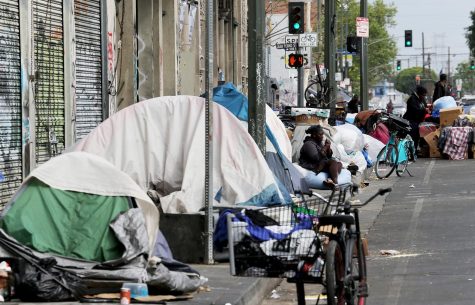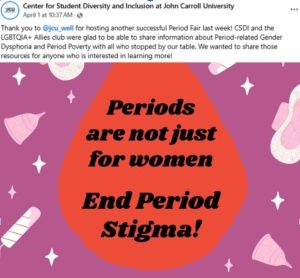The fulfilling and educational Boyle Heights Immersion Experience

Maia Echols writes about her rewarding and informative experience in Boyle Heights.
Nov 17, 2022
Living simply, traveling abroad with no technology of any kind and communicating with people through only face-to-face interactions for seven days can offer mixed feelings for anyone. Some people may think that this sounds relaxing while others believe that it is torture – I am one of those people who thought that it would be excruciatingly painful to leave behind my phone and focus on the present. But after embarking on a week-long journey to Boyle Heights, Los Angeles, I have to say that I would do it all over again.
Preparation for the Boyle Heights Immersion Experience began in December but I did not join until February. I had expressed my interest to Marie Steinkuhl, the student coordinator, about wanting to go on an immersion trip and she had told me that the Boyle Heights immersion had another spot open and I was more than welcome to join. I accepted the offer and began immersion preparation with the rest of the eight other members of my group. When preparing for the immersion, we spent multiple Thursdays discussing social injustices, language barriers and cultural differences between ourselves and to the region we would be venturing. Not only were our discussions fruitful, but we were also assigned to read “Barking to the Choir” by Father Greg Boyle who was in charge of establishing Homeboy Industries, the world’s largest gang-intervention and rehabilitation program.
On May 22, the Boyle Heights group gathered for a dinner in the Campus Ministry Conference Room (CMCR) and discussed what we were about to face, what kind of mindset we should go in with and the overall agenda of the trip. Everyone had mixed feelings of excitement and tension – I resonated more with the latter. Going on a trip without my phone, unable to contact my mom was daunting. However, I decided to just put my head in the game and go with the flow.
The next day, we left for the airport around 4:30 a.m. and I was barely tired. The excitement had finally gotten to me and I was ready to go on this journey. After we landed, Shelby, the Resident Minister on our trip, drove a van to Dolores Mission Catholic Church in Los Angeles. We were then greeted by Bella, our coordinator for the immersion. After Bella made sure that we were taken care of and comfortable, we began our day.
We started day one with a tour of Dolores Mission. Our tour was led by Father Ted who is a priest at the parish. While on this tour, he shared a story about a little boy that was raised by his own family because his mother had been deported.
After our tour with Fr. Ted, we met with a group of women who attended Dolores Mission and analyzed a prayer with them. We heard a mixture of Spanish and English from most of the women and we tried our best to speak to them in Spanish as well. To us, it was important to help make the women feel comfortable in their own environment, not forcing them to speak to us in a language that they were unfamiliar with.
Day two began with a trip to Homeboy Industries where we saw the “Thought for the Day.” When preparing for our immersion, we watched one of Fr. Boyle’s “Thought for the Day” speeches. Seeing it in person was something that I was really looking forward to and it did not disappoint.
We went to Homegirl Café and, later that same day, we toured Homeboy Silkscreen. There, we met with a man named Anthony who had 7 children, all with different mothers. He was involved with drugs and eventually everything caught up to him. He became a victim of gun violence, suffering 12 gunshot wounds and surviving. He knew, after that moment, he wanted his life to be different for the sake of his children. After our trip to Homeboy Silkscreen and hearing Anthony’s story, we had the opportunity to cook dinner for the Guadalupe Homeless Project, a shelter for homeless men in Boyle Heights.
From there, my perspective began to change. After making dinner for the men, I sat down with a few of them and we talked. I had the privilege of meeting and getting to know Don, someone who had gone through just about everything under the sun from drugs, to shootings, to having a family, to going to school. He was giving me advice on how to avoid getting into the same rut that he was in. I also met Thomas, a man who I shared many of the same interests with, and we had light hearted conversations about school, family and God.
The next day, we had a talk with Father Brendon at Dolores Mission in the morning and watched a talk on restorative justice given by a woman named Rosa. In the evening, we went to mass with Fr. Boyle.

On day four, we cooked breakfast for GHP and went to Skid Row. Skid Row is home to over 8,000 people experiencing homelessness. It is the largest street in the United States that those who experience homelessness occupy. While there, we met with Catholic Worker, Matt. He explained the role of Catholic Worker in Los Angeles. There, they run a soup kitchen that will go out and feed the unhoused living on Skid Row and make sure that they have what they need, as far as simple living goes. People will donate socks, clothes, food, hygiene products, and other necessities that Catholic Worker will deliver to them personally.
“Thursday was definitely one of the most life changing things that I have ever experienced. It allowed me to look at the world in a different perspective and taught me to appreciate and be grateful for the things that I have,” Sara Sfeir ‘24, a member of the immersion, said.
Day five was spent on the Santa Monica Pier where we reflected on what we had experienced on our trip thus far. On our last day, we wrapped up our trip by visiting the Juvenile Correctional Facility about an hour outside of Los Angeles. There, we spoke with a few college-age men about their lives. We talked about anything from what their families are like to what they wish could be different about their lives and whether or not they take back what they had done. We talked about how they are able to take college courses while in the correctional facility and what types of mental health resources are offered there.
Long story short, going on an immersion changed my life. The people of Boyle Heights told me stories and showed me experiences that I had never thought I would hear firsthand. I strongly recommend that everybody go on an immersion experience at some point in their life. Get out of your comfort zone and see something new. As Matt from Catholic Worker told me, “if you say your life has been changed – change it.”












Keegan Vogley • Feb 28, 2023 at 2:53 pm
Such a great read! It opens your eyes to a different lifestyle and how we can help those in need. I loved reading about your experience and would love to look into an immersion experience after reading about your Boyle Heights experience.
Cvanatta14 • Nov 20, 2022 at 10:49 am
Well written! Love hearing about this experience. I love Fr Gregory Boyle. You should Read all his other books too!